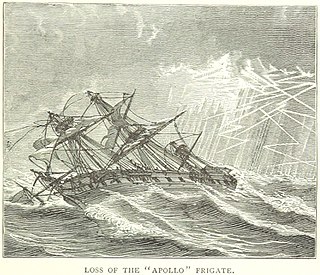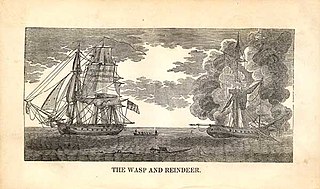
HMS Apollo, the fourth ship of the Royal Navy to be named for the Greek god Apollo, was a fifth-rate frigate of a nominal 36 guns. She was the name ship of the Apollo-class frigates. Apollo was launched in 1799, and wrecked with heavy loss of life in 1804.

HMS Reindeer was a Royal Navy 18-gun Cruizer-class brig-sloop of the Royal Navy, built by Samuel & Daniel Brent at Rotherhithe and was launched in 1804. She was built of fir, which made for more rapid construction at the expense of durability. Reindeer fought in the Napoleonic Wars before succumbing in 1814 to the guns of USS Wasp during the War of 1812.

HMS Ferret was a Royal Navy Cruizer-class brig-sloop built by Benjamin Tanner at Dartmouth and launched in 1806, 19 months late. She served on the Jamaica, Halifax, and Leith stations during which time she took three privateers as prizes before she was wrecked in 1813.
HMS Pike was a Royal Navy Ballahoo-class schooner of four 12-pounder carronades and a crew of 20. The prime contractor for the vessel was Goodrich & Co., in Bermuda, and she was launched in 1804. She captured one 10-gun enemy vessel before being herself captured, and recaptured.

HMS Haddock was a Royal Navy schooner of four 12-pounder carronades and a crew of 20. The prime contractor for the vessel was Goodrich & Co., in Bermuda, and she was launched in 1805.
On Thursday 21st inst launched off the stocks at Mr Isaac Skinner's shipyard his Majesty's Schooner "Haddock". The above schooner is said to be the completest vessel ever built in Bermuda

HMS Entreprenante, was a 10-gun cutter that the Royal Navy captured from the French in 1798. The British commissioned her in 1799 and she served during the French Revolutionary and Napoleonic Wars, participating in the Battle of Trafalgar. She has been the only ship of the Royal Navy to bear the name. She took part in several small engagements, capturing Spanish and French ships before she was sold in 1812 for breaking up.
HMS Saint Lucia was a brig-sloop, the former French Navy schooner Enfant Prodigue, which the British captured in 1803 and took into service with the Royal Navy. Under the British flag she captured three small French privateers and several prizes in the Leeward Islands before two French privateers recaptured her in 1807.
HMS Guachapin was a brig, the former Spanish letter of marque Guachapin, launched at Bayonne in 1800, which the British captured early in 1800 and took into service with the Royal Navy. Under the British flag she captured a Spanish privateer larger and better-armed than herself. She also served at the captures of the islands of St. Bartholomew, St. Martin, St. Thomas, St. Croix, Tobago, and St. Lucia, and of Surinam. She served at Antigua as a guard ship but was wrecked in 1811. She was then salvaged and sold.
HMS Dominica was a schooner that the British purchased in 1805 in the Leeward Islands. Her crew mutinied in 1806, turning her over to the French, who immediately sent her out as the privateer Napoléon. The British recaptured her four days after the mutiny and returned her to their service. In British service she captured some six small privateers. She was broken up in 1808.
HMS Dominica was the French privateer schooner J(T?)opo L'Oeil that the British captured in 1807 in the Leeward Islands. She took part in one inconclusive single-ship action before she foundered in 1809.
HMS Raposa was the Spanish brig Raposa, launched in 1804. She was captured A cutting out expedition in 1806 by boats from HMS Franchise in the western Caribbean captured her. The Royal Navy subsequently took her into service under her existing name. Raposa served in the Caribbean, repeatedly recapturing merchant ships that had fallen victim to French privateers. Thirteen months after being captured she ran aground while pursuing enemy ships. When they were unable to refloat Raposa, her crew set fire to her to avoid her capture, destroying her.
HMS Papillon was the French Navy's 12-gun brig Papillon, which the British captured in September 1803. She foundered in September 1805 with the loss of all her crew.
HM hired armed tender United Brothers was under contract to the Royal Navy from 5 June 1803 to 6 January 1807, though a French privateer captured her on 9 December 1806 off the Lizard. United Brothers had a burthen of 143 1⁄94 tons (bm). She was lightly armed, carrying four 3-pounder guns and six ½-pounder swivel guns.
HMS Netley was originally the French privateer brig Déterminé, which the Royal Navy captured in 1807 and took into service. She was lost at sea on the Leeward Islands station in 1808.
HMS Pultusk was the American-built French privateer sloop Austerlitz, which had been launched in 1805 and which the Royal Navy captured in 1807 and took into service as HMS Pultusk. Pultusk served in three campaigns, two of which resulted, some four decades later, in the award of medals, and one boat action that too received a medal. She was broken up in 1810.

HMS Barbuda was commissioned into the Royal Navy in 1780 after having briefly served as an American privateer. Barbuda was one of the two sloops that captured Demerara and Essequibo in 1781, but the French Navy captured her there in 1782 and took her into service as Barboude. The French Navy sold her to private owners in 1786, and she served briefly as a privateer in early 1793 before the French Navy purchased her again and named her Légère. She served them until mid-1796 when the Royal Navy captured her and took her into service as HMS Legere. She was wrecked off the coast of Colombia, without loss of life, in February 1801.
His Majesty's Hired armed cutter Sandwich served the Royal Navy from 23 May 1798 until the French frigate Créole captured her on 14 June 1799. She then served in the French Navy until the Royal Navy recaptured her on 15 October 1803. The Navy purchased her in 1804 and she served for some months in 1805 as HMS Sandwich before she was sold in Jamaica. During this period she captured three small French privateers in two days.
HMS Elizabeth was a French privateer schooner that the Royal Navy captured in 1805 and took into service under her existing name. She participated in an engagement and a campaign that earned her crews clasps to the Naval General Service Medal. She was lost with all hands in 1814 when she capsized in the West Indies.
HMS Tobago was a schooner of unknown origin that the British Royal Navy purchased in 1805. In 1806 a French privateer captured her. The Royal Navy recaptured her in 1809 and took her into service as HMS Vengeur before selling her later that year.
HMS Morne Fortunee was the French privateer Regulus that British Royal Navy captured in 1804. In 1806 the Royal Navy commissioned her. She captured some small privateers and took part in a number of other engagements. She foundered in 1809.





